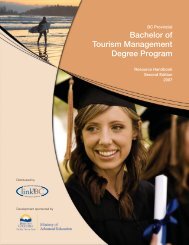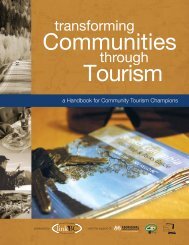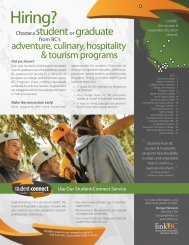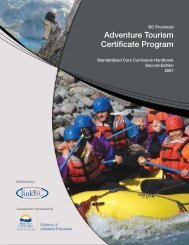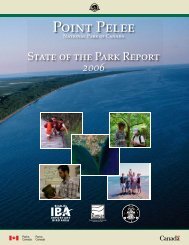Cultural Heritage Tourism Handbook - LinkBC
Cultural Heritage Tourism Handbook - LinkBC
Cultural Heritage Tourism Handbook - LinkBC
- No tags were found...
Create successful ePaper yourself
Turn your PDF publications into a flip-book with our unique Google optimized e-Paper software.
9. Develop Your Community’s <strong>Cultural</strong> Character & Themes 44Thorne’s <strong>Cultural</strong> <strong>Tourism</strong> ClustersRecognizing that “the place is the product,” cultural tourism specialist Steven Thorne developed aneffective planning process for his approach to community-based cultural/heritage tourism, whichhe coined “place-based cultural tourism.” Thorne’s work forms the basis of this chapter, where weexplore the concept in more detail.“When taken to market, a place-based cultural/heritage tourismdestination invites the visitor to experience much more than the destination’scultural ‘attractions.’ The attractions are there, but they areexpressions of the destination’s culture rather than its embodiment. Thebranding, imaging, and messaging developed for the marketing campaigncommunicates the destination’s cultural character and sense ofplace as much as it profiles the attractions themselves.”– Steven ThorneThe following clusters are a tool that helps your community zero in on your cultural character.1. Human <strong>Heritage</strong>. Experiences that reveal the tangible and intangible legacy of human settlement and development:Tangible:• Aboriginal heritage experiences• Archaeological sites• Architecture• Archives• Botanical/decorative gardens• Community walking/driving tours• <strong>Cultural</strong> & historic districts• <strong>Heritage</strong> events & festival• <strong>Heritage</strong> home tours• Historic sites• Human heritage museums• Libraries & learning events• Pioneer villages/living history sites• Statues & monuments• StreetscapesIntangible:• Customs & traditions• Folklore• Language & idioms• Religion2. Agricultural & Industrial <strong>Heritage</strong>. Experiences that reveal the legacy of human settlement and development specific toagriculture and industry:• Agricultural festivals• Agricultural museums• Farmers’ & fishers’ markets• Industrial museums• Industrial factory tours• Farm & orchard tours• Tours of artisanal food productionfacilities• Tours of artisanal product manufacturingfacilities• Winery tours629.1 Build on Your Inventory: Clusters & ThemesAs discussed in chapter 7, one of the first steps to creating a communitybasedcultural/heritage tourism strategy is to build an inventory ofavailable experiences. From there, with guided discussion, your community’sunique cultural character can be identified. This unique culturalcharacter can form the core of stories and marketing themes, which thentie together your cultural/heritage products and experiences.A cultural/heritage tourism task force, working through an experiencedfacilitator, can make great progress at this stage. In a workshop setting,community members identify all cultural/heritage tourism experiencesthey can think of. Using Thorne’s place-based planning approach, eachexperience is assigned to its appropriate cultural cluster of:• Human heritage• Agricultural and industrial heritage• The arts• Cuisine, and• Natural historyIn addition to tangible assets, Thorne advises that intangible heritageassets that help create the community’s cultural character can also beidentified in this exercise (e.g. culture & traditions, folklore, languageand idioms, and religion), adding an important layer of information tothe inventory.3. The Arts: Experiences of the performing, visual, literary, and media arts:• Artist-run centres• Art instruction classes & retreats• Artist studios• Bookstores featuring local/regionalauthors• Commercial art & craft galleries• Literary arts events & festivals• Live music & comedy clubs• Media arts events & festivals• Multi-disciplinary arts events & festivals4. Cuisine. Experiences of foods, wines and beverages, including their history and production:• Artisanal foods & beverages• Beverage events & festivals• Culinary/cooking classes & retreats• Dining experiences (restaurants, bistros,coffee houses, pubs)• Performing arts events & festivals• Public art• Public art galleries• Visual arts events & festivals• Food events & festivals• Wine festivals & tastings5. Natural History*. Experiences that reveal the relationship between the natural environment and human settlement and development:• Natural history festivals• Natural history museums• Natural history tours• Nature interpretation centres* ”The land shapes its people, and people shape their land. A community’sculture cannot be fully understood or appreciatedwithout interpreting the land, even in an urban environment.”– Steven ThorneThis sorting and categorizing of the experiences can reveal whatThorne calls the destination’s “cultural character”. The themes that• Parks & interpreted nature trails• Scenic landscapes & vistasemerge from the destination’s cultural character can be then usedto guide marketing efforts. He continues, “the destination’s culturalthemes are not imposed; they emerge through the place-basedplanning process. Through this process, any destination can identifyits unique cultural themes, [which] help visitors navigate the highvolume of experiences and ...to understand, and appreciate, thedestination’s sense of place.”63



